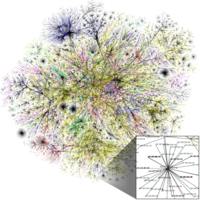
Photo from wikipedia
INTRODUCTION Studies on PIU are mostly on the non-clinical population. Understanding the experiences of adolescents with problematic internet use (PIU) is critical in shaping nursing interventions and improving the quality… Click to show full abstract
INTRODUCTION Studies on PIU are mostly on the non-clinical population. Understanding the experiences of adolescents with problematic internet use (PIU) is critical in shaping nursing interventions and improving the quality of care. AIMS A comprehensive description of the experiences of adolescents with problematic internet use. METHODS In the study, descriptive phenomenology design, one of the qualitative research methods, was used. Data were collected using a personal information form and a semi-structured interview form and analyzed using Giorgi's phenomenological method (n = 11). RESULTS As a result of the content analysis, five main themes were identified: reasons of problematic internet use, internet-related perceptions, experiences in accessing the internet, experiences in not being able to access the internet, and consequences of internet use. DISCUSSION Different from previous studies, adolescents stated that they use the internet because of their lack of activity and their need to spend time with their friends. They stated that when they could not access the internet, they thought they could never live without the internet and started quarrel. IMPLICATIONS FOR PRACTICE Mental health nurses can use family process maintenance, behavior modification: social skills, mood management, activity therapy and cognitive restructuring interventions when caring for adolescents with PIU.
Journal Title: Journal of psychiatric and mental health nursing
Year Published: 2023
Link to full text (if available)
Share on Social Media: Sign Up to like & get
recommendations!